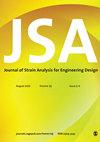Dual-phase-lag thermoelastic damping analysis of a functionally graded sandwich micro-beam resonators incorporating double nonlocal effects
IF 1.8
4区 工程技术
Q3 ENGINEERING, MECHANICAL
Journal of Strain Analysis for Engineering Design
Pub Date : 2023-08-28
DOI:10.1177/03093247231194690
引用次数: 0
Abstract
Functionally graded sandwich micro/nano-structures have attracted great attention due to the capability to resist high noise and thermal stress in a non-isothermal environment. Additionally, the design of high quality-factor micro/nano-resonators requires accurate estimation of their thermoelastic damping. However, the classical thermoelastic damping models fail at the micro/nano-scale due to the influences of the size-dependent effects related to heat transfer and elastic deformation. This work aims to investigate the influences of the size-dependent effects on the thermoelastic damping of functionally graded sandwich micro-beam resonators by combining the nonlocal dual-phase-lag heat conduction model and the nonlocal elasticity model. It is assumed that the functionally graded sandwich micro-beam resonators consist of a ceramic core and functionally graded surfaces. The energy equation and the transverse motion equation are derived. The analytical expression of thermoelastic damping is obtained by complex frequency method. Numerical results are analyzed for the effects of the thermal nonlocal parameter, the elastic nonlocal parameter, the power-law index, and the vibration modes on the thermoelastic damping of functionally graded sandwich micro-beam resonators. The results show that the thermoelastic damping of functionally graded sandwich micro-beam resonators can be adjusted by the suitably modified parameters, which strongly depends on the double nonlocal effects and the power-law index.含双非局部效应的功能梯度夹层微束谐振腔的双相位滞后热弹性阻尼分析
功能梯度夹层微纳米结构因其在非等温环境下抗高噪声和热应力的能力而备受关注。此外,高质量因子微/纳米谐振器的设计需要精确估计其热弹性阻尼。然而,经典的热弹性阻尼模型在微/纳米尺度上由于与传热和弹性变形相关的尺寸依赖效应的影响而失效。本工作旨在结合非局部双相滞后热传导模型和非局部弹性模型,研究尺寸依赖效应对功能梯度夹层微束谐振器热弹性阻尼的影响。假设功能梯度夹层微束谐振器由陶瓷芯和功能梯度表面组成。导出了能量方程和横向运动方程。用复频率法得到了热弹性阻尼的解析表达式。数值结果分析了热非局部参数、弹性非局部参数、幂律指数和振动模态对功能梯度夹层微束谐振器热弹性阻尼的影响。结果表明,夹层微束谐振器的热弹性阻尼可以通过适当的参数调整来调节,这主要依赖于双非局部效应和幂律指数。
本文章由计算机程序翻译,如有差异,请以英文原文为准。
求助全文
约1分钟内获得全文
求助全文
来源期刊

Journal of Strain Analysis for Engineering Design
工程技术-材料科学:表征与测试
CiteScore
3.50
自引率
6.20%
发文量
25
审稿时长
>12 weeks
期刊介绍:
The Journal of Strain Analysis for Engineering Design provides a forum for work relating to the measurement and analysis of strain that is appropriate to engineering design and practice.
"Since launching in 1965, The Journal of Strain Analysis has been a collegiate effort, dedicated to providing exemplary service to our authors. We welcome contributions related to analytical, experimental, and numerical techniques for the analysis and/or measurement of stress and/or strain, or studies of relevant material properties and failure modes. Our international Editorial Board contains experts in all of these fields and is keen to encourage papers on novel techniques and innovative applications." Professor Eann Patterson - University of Liverpool, UK
This journal is a member of the Committee on Publication Ethics (COPE).
 求助内容:
求助内容: 应助结果提醒方式:
应助结果提醒方式:


